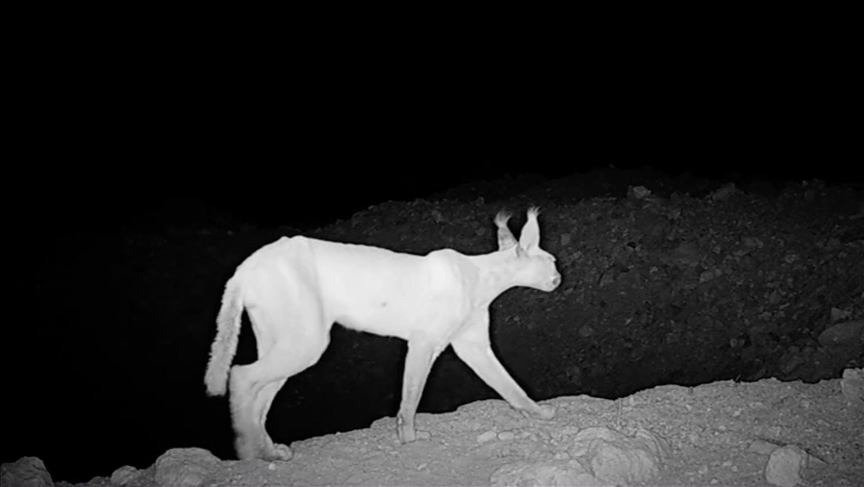Caracal sightings offer hope as Pakistan’s rare wild cat nears local extinction
Habitat loss, human intrusion and retaliatory killings have pushed Pakistan’s rare caracal cat to critically endangered status

- Conservationists recently captured rare camera-trap footage of a caracal in Sindh province, confirming the species still survives in the country
- Experts warn the elusive predator’s disappearance would upset fragile ecosystems across Pakistan’s deserts and highlands
KARACHI, Pakistan
In the dry hills west of Karachi, a caracal moves silently across rocky terrain, its long, black-tufted ears twitching at every sound. A hidden camera captures the fleeting moment, offering rare evidence that one of Pakistan’s most elusive wild cats still survives.
The caracal, a medium-sized wild cat native to arid regions of Africa, the Middle East, Central Asia and South Asia, is now critically endangered in Pakistan. Wildlife experts warn that habitat loss, increasing human intrusion, and retaliatory killings have pushed the species to the brink of local extinction.
“Local people either kill the cat to protect their sheep, goats, deer and other small animals, or in retaliation for its preying on small livestock,” wildlife expert Saeed-ul-Islam told Anadolu.
Hunting for the illegal pet trade poses another threat.
“This has left the animal’s population in only a few hundred, not even a thousand, in Pakistan,” he said.
Javed Mahar, conservator with Sindh’s Wildlife Department, said the caracal still exists in parts of Sindh and other provinces, but that the absence of official data makes it difficult to assess its population.
One estimate puts the number between 100 and 200.
Typically nocturnal and highly secretive, the caracal is a solitary carnivore that preys on birds, rodents and small mammals. It is known for its long legs, tufted ears and remarkable hunting agility. The species is near extinction in North Africa, critically endangered in Pakistan and endangered in Jordan, though populations remain stable in parts of central and southern Africa.
New hopes for survival
In Pakistan, the species clings to survival in the Cholistan Desert of Punjab province, Sindh’s Kirthar Range, and the highlands of central and southern Balochistan, said Zafeer Ahmad Shaikh, head of the Indus Fishing Cat Project (IFCP), a wildlife conservation group active in the region for more than four years.
Conservationists recently recorded a caracal on the southern outskirts of Kirthar National Park near Karachi, offering rare visual evidence that the once widespread species still exists there.
“We spent weeks trying to spot this rare species, which we thought no longer existed in this part of Pakistan,” said Zohaib Ahmad, one of the conservationists who set up a camera trap after reports of a caracal crossing a nearby road in daylight in January.
“This is the first camera-trap record of a caracal in years,” he told Anadolu. “It offers firm evidence that caracals are still present in Pakistan.”
The footage, recorded by IFCP, shows an adult male caracal wandering through the hilly terrain of Kirthar National Park. Out of about 400 clips collected from that camera over two weeks, it was the only one showing a caracal, Shaikh said.
Another recent sighting involved a juvenile killed by local residents in the same area, he added.
Pressures driving decline
Jamshed Chaudhry, an official with WWF-Pakistan, said caracals are rapidly losing their natural habitat due to farmland expansion, urban development and overgrazing, all of which make it harder for them to find food and shelter.
“Caracals are also struggling to survive as their prey – rodents, birds and reptiles – are declining due to habitat loss, overgrazing and hunting, leaving them with little to no food,” Chaudhry told Anadolu.
He added that roads cutting through caracal habitats pose another danger, as the cats are most active at dawn and dusk, when drivers are less likely to see them in time.
While not common, Chaudhry said, the species is sometimes hunted for its skin or captured for the illegal wildlife trade, adding further pressure to an already small population.
The caracal receives limited legal protection in Pakistan and little focused conservation attention, allowing its decline to go largely unnoticed.
The species has largely remained outside mainstream wildlife protection programs, though WWF-Pakistan and other groups have occasionally recorded its presence during biodiversity surveys in Cholistan, Thal and parts of Balochistan.
It is protected under the Sindh Wildlife Act, which bans poaching and hunting, though enforcement remains a challenge.
Ecological balance
Experts stress that the caracal plays an important role in maintaining ecological balance.
“Their regulation of prey species is essential for sustaining biodiversity and the overall health of the ecosystem,” Chaudhry said.
Mahar echoed the view, explaining that the caracal helps maintain the prey-and-predator balance in ecosystems.
As a predator, it regulates populations of its prey, including rodents and small mammals, a natural balance that prevents overgrazing, crop loss and the spread of disease.
“Protecting caracals, therefore, not only conserves a unique and graceful predator but also ensures the stability of entire ecosystems they are part of,” Chaudhry said.
Anadolu Agency website contains only a portion of the news stories offered to subscribers in the AA News Broadcasting System (HAS), and in summarized form. Please contact us for subscription options.







